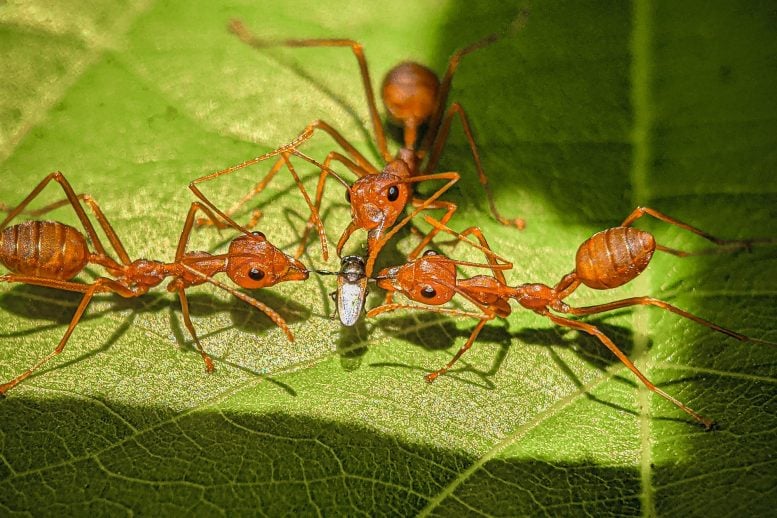
On a Puerto Rican coffee farm, researchers uncovered a surprising web of chaos among ants and a predator fly.
Three ant species compete in shifting cycles of dominance, but when a fly targets the strongest species, the balance flips unpredictably. These swings create wild oscillations where any species can rise to the top.
Understanding Ecology for Pesticide-Free Farming
To reduce or even eliminate the use of pesticides, University of Michigan researchers emphasize the importance of understanding how ecological systems function within farmland.
John Vandermeer and Ivette Perfecto of U-M have applied two ecological theories to explain the complex relationships between three species of ants and a newly introduced fly that preys on one of them. On a coffee farm in Puerto Rico, they discovered that the ants and the predator fly create what scientists call chaotic patterns—chaos in the classical sense, where natural populations rise and fall based on the shifting interactions of different organisms in the system.
This instability means that any of the four insect species involved could become dominant at different times. If farmers can anticipate which ants will take the lead, they may be able to use them as natural pest managers. The study, supported by the National Science Foundation, appears in the Proceedings of the National Academy of Sciences.
Predicting Ant Dominance Is Tricky
“Two of the three ant species we studied are really important agents of biological control of two of the important pests in coffee,” said Vandermeer, U-M professor of ecology and evolutionary biology. “We would like, or a farmer would like, to be able to predict when the ants are going to be there, and when they’re not going to be there. And it turns out that that kind of prediction is going to be pretty difficult.”
For more than thirty years, Vandermeer and Perfecto, a professor at U-M’s School for Environment and Sustainability, have been investigating how ants interact in the farm’s ecosystem. Their long-term goal is to reshape agricultural practices, but they argue that this is only possible once the ecological rules governing these systems are understood.
“We believe that the current international agricultural system with its use of pesticides and chemicals is not contributing to the welfare of anybody, especially the farmers, and is actually contributing quite a bit to global climate change,” Vandermeer said. “We take the position that in order to incorporate the rules of ecology into the development of new forms of agriculture, we need to understand what those rules are and how those rules work.”
Ants as Key Pest Controllers in the Tropics
In the tropics, ants are dominant, Vandermeer says, and often involved in agriculture as agents of controlling pests. But using an ant species to control pests can be complicated: The dominance of the ant being used as a biological control depends on what other species of ants—as well as other types of insects—are in the system.
In this system, Vandermeer and Perfecto examined two types of ecological behavior: intransitive loop cyclic behavior and predator-mediated coexistence. Intransitive loop cyclic behavior means that if there’s a group of three ant species, Ant A might be dominant over Ant B, Ant B might dominate Ant C, but Ant C could dominate Ant A.
Predator Fly Shakes Up the System
When a predator is thrown into the mix, these dynamics become even more complicated. Among the three species of ants that Vandermeer and Perfecto study, one species is dominant. But the recently introduced fly preys upon the dominant ant. This predator-prey relationship not only affects the dominant ant, but it also has downstream effects on the other two ant species, allowing any of the four species to become the dominant species at different points in time. This is an example of predator-mediated coexistence.
The waxing and waning of the predator fly and its ant target, as well as the change of dominance in the ant species, are called oscillations. By overlapping and modeling these two oscillating ecological principles, the researchers could examine how the principles introduce chaos into the system.
Mapping the Chaos
The results are … chaotic. But by plotting both of these oscillating behaviors, the researchers were able to see that at certain times, the whole system looked like a predator-prey cycle, and at other times, the system looked like an intransitive loop oscillation.
This could mean—in theory—the researchers could get a window into when each insect species was going to be the dominant species.
Complications in Applying Ecology to Farming
“The good news is that the chaotic patterns of the insects are really very interesting from an inherent intellectual sense. The bad news is that it’s not really as simple as it might seem to base agricultural practices on ecological principles because the ecological principles themselves are way more complicated than simply finding a poison that kills the pests,” Vandermeer said.
“What we’re uncovering, we think, over the past 30 years or so are some of those complications that come out if you’re serious about putting ecology into the fundamental operations of the agricultural system.”
Reference: “Keystone predator and keystone intransitivity and the rescue of a competitively subdominant species” by John Vandermeer and Ivette Perfecto, 11 August 2025, Proceedings of the National Academy of Sciences.
DOI: 10.1073/pnas.2421005122
Never miss a breakthrough: Join the SciTechDaily newsletter.